Kenya 2009
Trip Report
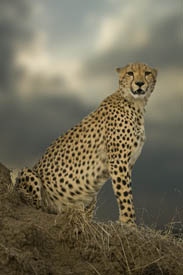
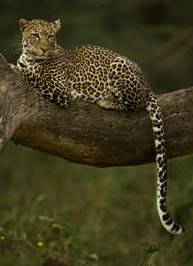
This year, because of a scheduled trip to Antarctica in November, we were limited to only two Kenya Photo safaris that covered the month of October. In summary, our time in Kenya was too short, and as I write this report in Nairobi I only wish we had another four weeks to spend here! Nonetheless, the two trips were great, with plenty of highlights.
Our 2010 Safari Brochures are now available.
15 day trip
19 day trip
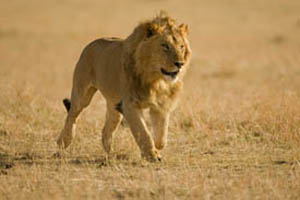
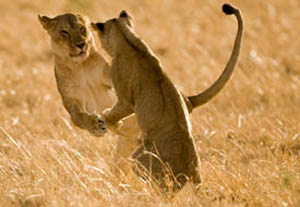
On Trip One, we had two male lions pursuing a lioness for nearly a half mile. We think the males had just taken over the pride, had killed her two cubs, and she was having nothing to do with the males.
On Trip Two, in the first hour of light, two lionesses wrestled playfully after feeding upon a gnu.
The Weather
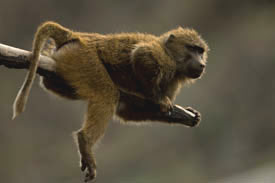
October is the start of the short rainy season and, this year, the rains were late. It hadn’t rained since January, and the country was suffering from drought, and we wondered how this would affect our game viewing.
In Samburu, the drought had been so devastating that the Samburu people had actually abandoned their livestock, and we found donkeys and cattle deep inside the park, and plenty of carcasses of both. Starvation had killed many of the livestock, and although we saw, for the first time, dead buffalo, oryx, and zebra that apparently had also succumbed to the reduced forage, most of the wild game was surprisingly, and refreshingly, healthy. We did see one young elephant in the throes of death, pathetically waving its legs in the air as it lay upon its side, and Mary shot a warthog that appeared to be all head, as its body was so shrunken that its bony head seemed to occupy its entire mass.
Elephants were in far fewer numbers than normal, and were scattered around the park. Most of the elephants had moved into the mountains where trees and forage would be more plentiful. We found this refreshing, as the elephants of Samburu have hammered the riverside vegetation terribly, and a concentration of elephants along the river is always harmful.


A common sandpiper flies from one hippo to another; and a baby White Rhinoceros
loses its nerve and runs back to its mother. In Lake Nakuru, we almost always find
white rhinos, and usually find Africa's other rhino species, the Black Rhino. White
rhinos are so named because their mouths are wide, or 'weit', and this word has
been misinterpreted as meaning 'white' and not wide as it was meant to be understood.
During our two visits, however, the Usao Nyro River went from a sandy thread, pocketed by the diggings of man or elephants to create wells to reach subterranean water, to, on our second trip, a healthy brown flood as rains had finally reached the high country, the watershed for Samburu, and although rain had not reached the park in any amount, water had at least returned to the river.
In the Masai Mara, the Mara River grew shallower as the month passed, and on our second trip our gnu river crossings were merely ‘river wadings’ as the water was so shallow that the gnus could walk across the river and did not have to swim. Still, on both trips we had Nile Crocodiles catch gnus or zebras, and we also watched several attempted snatches. There is a huge amount of anticipation and anxiety as one stands and waits, watching as huge crocodiles slowly push forward in the current until they lie abreast of the passing gnus or zebras. At one crossing, when the river was still high, zebras actually jumped and walked over the crocodiles lying in their path, as the crocs were still sated from other meals. Eventually, though, a gnu or zebra moved too close, or proved too tempting, and a crocodile would lunge, and we have several shots as the gnu-sized jaws of a crocodile snapped at a gnu, grazing its hide but not capturing it within its steel trap jaws.
By the end of our second trip the rains had returned to both the Mara and Samburu, and on our last days in the Mara we had some rain in the afternoon, and nice, soft light through the morning on several days.

The Migration
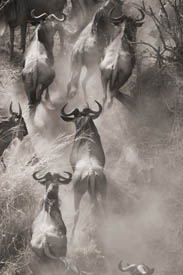
Gnus, traditionally, have entered the Masai Mara some time in June or early July, and stayed until late August or through September. That ‘traditional’ pattern has changed over the last number of years and this year it appeared as if the migration was just entering the Mara at the beginning of our first trip. Actually, the gnus had arrived earlier, but many had left, and what we were seeing is another return of bands of gnus for at least the second time this season. Still, it made for great shots of skeins and snaking trails of hundreds or thousands of gnus across the grasslands.
By our second trip the ‘migration’ was over, and now many of the grasslands were covered with herds of grazing gnus, giving a different, but quite as accurate, picture of the great gnu migration. In places there were as many gnus as we’ve ever seen within the Mara, and herds were constantly on the move, crossing and recrossing the Mara River.
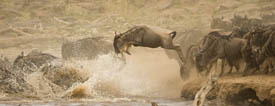
On both our trips we were extremely lucky in not having to wait, at all, for gnus to settle along the river’s edge and decide to cross. And, on trip one, we had one of our most dramatic crossings in a very long time, as animals gathered in a cloud of dust and executed high, arching leaps into the river.
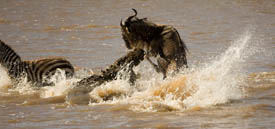
On trip two the almost dry, and aptly named, Sand River hosted an enormous congregation of gnus, and we made some spectacular shots as gnus raced up narrow, dusty hippo shoots as they crossed the stream bed. Along this river the gnus almost seemed confused, as the huge herds formed several lines that curved in a broad arch almost to the point where the leading edge of the line met the trailing edge of the same herd. From the air, had we had the chance, we might have seen a complete circle at times, as if the gnus were in a continuous loop that would never end. Knowing gnus, I could almost see that happening!
The Predators
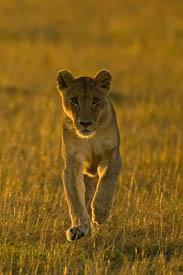
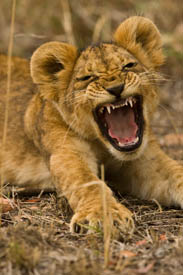
For whatever reason, this year we saw more hunts than we’ve ever had, and although most of these were not successful (generally less than 50% ever result in a kill), we had plenty of action watching stalks, chases, and ‘hits’ where the predator fell off its prey. On both trips members of our group saw lions hunting zebras. In one, the lion reared up for its final grasp but was kicked off by the zebra, while in another, the lion actually knocked the zebra down, but it regained its footing and slipped from beneath the lion!
With cheetahs, some participants saw an oribi captured, and everyone saw two exciting hunts of atypical prey – a reedbuck and a warthog For the reedbuck, we had just left our lodge when a gathering of mini-vans alerted us to some activity. When we arrived, we discovered three cheetahs, a mother with two nearly full-grown cubs, hunting, and as we watched they focused their attention on a mixed group of impala and reedbuck.
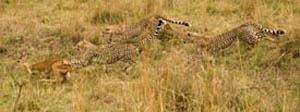
One of the cheetahs held back while the mother climbed a small hill and surveyed the potential prey from a termite mound. One of the cubs stalked forward, hidden from the impala by a low ditch close to the roadside where we watched. That cheetah was focused upon a small group of impala, and did not see that a reedbuck was close by, and was being watched by the mother cheetah. Fortunately, at the last minute the cheetah noticed the reedbuck first, and the cat changed direction and charged. Everything happened so fast, but the end result was that all three cheetahs bore down upon the reedbuck, which ran directly towards our vehicle. Using a 70-200mm lens, (see the November Tip of the Month)I was able to catch all of the activity within the frame!
On the very last game drive of our last safari we had our third great cheetah hunt. We had been following three cheetah brothers through the morning, but as noon arrived and the cats settled beneath an acacia tree to sleep, and with no game in sight, we headed back to camp. We left early that afternoon to rejoin the cheetahs, and as luck would have it, the cats had awakened and were now stalking some topis. Topis are large antelopes and usually immune to cheetah attacks, but three adult male cheetahs can take a topi, and these three male cats were specializing on large antelopes.
We watched as the three brothers began their stalk, actually walking right passed a few of our vehicles and melting, belly-flat, into the grasses as they watched a lone topi approach. Slowly, the cats stalked forward until only about 100 yards separated two of the cheetahs from the topi. A chase was imminent, but then the third cheetah decided to join the other two, and incautiously advanced. The topi spotted it and trotted off, and that hunt was blown!
We were very disappointed, but within minutes the cheetahs set their attention on a different quarry, a family of warthogs further down the hill. Two of the cats moved in quickly, and got quite close without the warthogs noticing. One raced forward, and quickly grabbed a baby warthog. Before it could carry the warthog off, however, one of the adult warthogs charged to its rescue and smashed into the cheetah!
The cheetah released the baby warthog and ran off, with the irate parent warthog in close pursuit. Other warthogs ran about, and in the confusion the baby warthogs were vulnerable, and the two other cheetahs successfully grabbed babies and ran off. Eventually, the warthog adults gave up their pursuit and the last cheetah returned to its brothers, and promptly stole the warthog back from one of the three. It was a great ending (although maybe not for baby warthogs) to a great safari, and a fitting conclusion to our short time in Kenya this year.
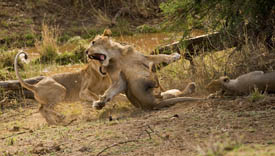
We had another interesting first as well. Although we usually see a few lions in Samburu, we normally don’t see prides in this arid park but this year, because of the water being restricted to a few springs or the river, the lions were concentrated and very visible. One day, shortly after we found a pride, we watched as a male lion charged a younger male. Snarls and growls erupted and the action finished quickly, but we stayed on, waiting. Not long after, the male lion approached another lion and, without preamble, attacked. There was snarling and roaring as the male hovered over the other lion as it lay on its back and tried defending itself. Seconds later, a lioness rushed to the aid of the lion being attacked and bit into the thigh of the male lion. He turned and snarled and swiped, falling on his back as he turned his attention to the attacking lioness. She dodged his swipes and walked off, and soon the pride followed, with the now chastened male lion following behind, eventually flopping down beside a palm tree where it spent the rest of the day.
The Birds
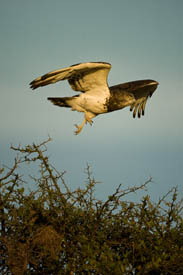
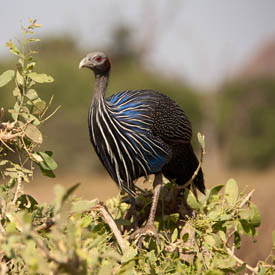
Because of the drought, the first safari saw little breeding activity, but we still managed to photograph plenty of birds. On the second trip, however, the brief showers triggered courtship activity, especially in Samburu, and we saw and heard hornbills, crested bustards, and weavers begin their nesting cycle.
There were so many bird highlights, on both trips, that they were too numerous to mention. Although the drought impacted upon breeding, bird life was concentrated in many spots and the group did well with lilac-breasted rollers, various birds of prey, and numerous songbirds. Birds, as it turns out on every trip, ends up to be some photographers favorite subjects and favorite shots, even though many of those photographers did not expect to photograph birds, or have an interest in doing so beforehand. Typically, a safari shoots over 50 different species, and collectively, usually over 100 species among the group! This year, for the first time, groups had extraordinary luck with one of the most colorful and elusive birds, the golden-breasted starling. Several photographers got shots of them in flight, and full-frame portraits as well.
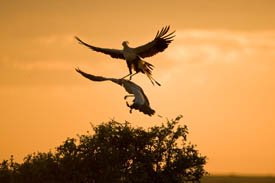
Other Highlights
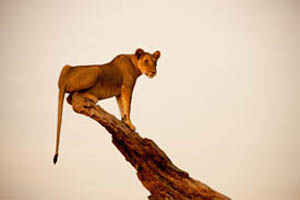
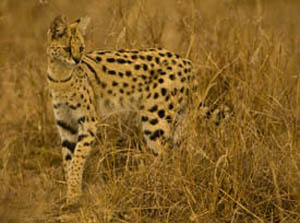
On trip one, we set a new record one morning, with FOUR different adult leopards in one morning.
We had two male lions bounding across the Mara as they chased a lioness, passing unconcernedly right passed our vehicles.
On our last day in Samburu we had two lionesses perched atop a dead snag in beautiful low light.
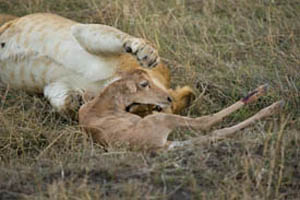 In the Mara, we had a lioness capture a topi baby right next to the road, but instead of killing the antelope the lioness played with it instead. Eventually she carried it off and out of sight, no doubt to dine.
In the Mara, we had a lioness capture a topi baby right next to the road, but instead of killing the antelope the lioness played with it instead. Eventually she carried it off and out of sight, no doubt to dine.
On trip two we had one of the most interesting ‘river crossings,’ but instead of crossing the Mara River a huge herd crossed and recrossed the Sand River into Tanzania. At one point the gnus, circling about, practically made a complete circle, and it was possible that the stream might have united into one big circle as the leaders of the column curved about and joined the trailers at the end of their own column. The herd shots, dust, and ambiance was simply spectacular.
In Samburu we found a cooperative leopard with a carcass near a track, and in the afternoon the leopard left the tree and, calling, walked right passed many of our vehicles as it sought a new perch, or perhaps hidden cubs we never saw. In Nakuru, we had another leopard, a big male perched on a log in clear view and close; a view we haven’t had of a Nakuru leopard in many years.
For the first time, ever, I saw an African hedgehog in the wild, curled in a defensive ball beside the road.
For packing and organizing our gear, Mary and I both use the McDonald Safari Long Lens bag (at least that's what I call it) for our 500mm. Several of our participants had this long lens bag, too, and every one of them said they were extremely happy to have the bag, and couldn't imagine functioning without it.
For the rest of my equipment -- two cameras, one with a 28-300 attached, and the other with a 70-200, and a flash and 16-35mm, I used my new Kiboko backpack that I did a Question of the Month about recently. This lightweight bag really works, and in this, my second real field test, I thought the bag performed flawlessly. A few participants had this bag, too, and I suspect a lot more olks will be using it as the word spread.
See Mary's Portfolio from these trips.
For even more details about either safari, read my daily journal for Safari Trip One or Safari Trip Two.
Interested in doing one of our safaris? Check out our brochure.
For some real insight into all aspects of a photo safari,
order our DVD Photographing on Safari
which covers and illustrates various camps,
how to shoot from the vehicles, what to pack,
and most importantly, what you'll photograph
and how you'll do so.
Kenya 2009
Trip Report


This year, because of a scheduled trip to Antarctica in November, we were limited to only two Kenya Photo safaris that covered the month of October. In summary, our time in Kenya was too short, and as I write this report in Nairobi I only wish we had another four weeks to spend here! Nonetheless, the two trips were great, with plenty of highlights.
Our 2010 Safari Brochures are now available.
15 day trip
19 day trip


On Trip One, we had two male lions pursuing a lioness for nearly a half mile. We think the males had just taken over the pride, had killed her two cubs, and she was having nothing to do with the males.
On Trip Two, in the first hour of light, two lionesses wrestled playfully after feeding upon a gnu.
The Weather

October is the start of the short rainy season and, this year, the rains were late. It hadn’t rained since January, and the country was suffering from drought, and we wondered how this would affect our game viewing.
In Samburu, the drought had been so devastating that the Samburu people had actually abandoned their livestock, and we found donkeys and cattle deep inside the park, and plenty of carcasses of both. Starvation had killed many of the livestock, and although we saw, for the first time, dead buffalo, oryx, and zebra that apparently had also succumbed to the reduced forage, most of the wild game was surprisingly, and refreshingly, healthy. We did see one young elephant in the throes of death, pathetically waving its legs in the air as it lay upon its side, and Mary shot a warthog that appeared to be all head, as its body was so shrunken that its bony head seemed to occupy its entire mass.
Elephants were in far fewer numbers than normal, and were scattered around the park. Most of the elephants had moved into the mountains where trees and forage would be more plentiful. We found this refreshing, as the elephants of Samburu have hammered the riverside vegetation terribly, and a concentration of elephants along the river is always harmful.


A common sandpiper flies from one hippo to another; and a baby White Rhinoceros
loses its nerve and runs back to its mother. In Lake Nakuru, we almost always find
white rhinos, and usually find Africa's other rhino species, the Black Rhino. White
rhinos are so named because their mouths are wide, or 'weit', and this word has
been misinterpreted as meaning 'white' and not wide as it was meant to be understood.
During our two visits, however, the Usao Nyro River went from a sandy thread, pocketed by the diggings of man or elephants to create wells to reach subterranean water, to, on our second trip, a healthy brown flood as rains had finally reached the high country, the watershed for Samburu, and although rain had not reached the park in any amount, water had at least returned to the river.
In the Masai Mara, the Mara River grew shallower as the month passed, and on our second trip our gnu river crossings were merely ‘river wadings’ as the water was so shallow that the gnus could walk across the river and did not have to swim. Still, on both trips we had Nile Crocodiles catch gnus or zebras, and we also watched several attempted snatches. There is a huge amount of anticipation and anxiety as one stands and waits, watching as huge crocodiles slowly push forward in the current until they lie abreast of the passing gnus or zebras. At one crossing, when the river was still high, zebras actually jumped and walked over the crocodiles lying in their path, as the crocs were still sated from other meals. Eventually, though, a gnu or zebra moved too close, or proved too tempting, and a crocodile would lunge, and we have several shots as the gnu-sized jaws of a crocodile snapped at a gnu, grazing its hide but not capturing it within its steel trap jaws.
By the end of our second trip the rains had returned to both the Mara and Samburu, and on our last days in the Mara we had some rain in the afternoon, and nice, soft light through the morning on several days.

The Migration

Gnus, traditionally, have entered the Masai Mara some time in June or early July, and stayed until late August or through September. That ‘traditional’ pattern has changed over the last number of years and this year it appeared as if the migration was just entering the Mara at the beginning of our first trip. Actually, the gnus had arrived earlier, but many had left, and what we were seeing is another return of bands of gnus for at least the second time this season. Still, it made for great shots of skeins and snaking trails of hundreds or thousands of gnus across the grasslands.
By our second trip the ‘migration’ was over, and now many of the grasslands were covered with herds of grazing gnus, giving a different, but quite as accurate, picture of the great gnu migration. In places there were as many gnus as we’ve ever seen within the Mara, and herds were constantly on the move, crossing and recrossing the Mara River.

On both our trips we were extremely lucky in not having to wait, at all, for gnus to settle along the river’s edge and decide to cross. And, on trip one, we had one of our most dramatic crossings in a very long time, as animals gathered in a cloud of dust and executed high, arching leaps into the river.

On trip two the almost dry, and aptly named, Sand River hosted an enormous congregation of gnus, and we made some spectacular shots as gnus raced up narrow, dusty hippo shoots as they crossed the stream bed. Along this river the gnus almost seemed confused, as the huge herds formed several lines that curved in a broad arch almost to the point where the leading edge of the line met the trailing edge of the same herd. From the air, had we had the chance, we might have seen a complete circle at times, as if the gnus were in a continuous loop that would never end. Knowing gnus, I could almost see that happening!
The Predators


For whatever reason, this year we saw more hunts than we’ve ever had, and although most of these were not successful (generally less than 50% ever result in a kill), we had plenty of action watching stalks, chases, and ‘hits’ where the predator fell off its prey. On both trips members of our group saw lions hunting zebras. In one, the lion reared up for its final grasp but was kicked off by the zebra, while in another, the lion actually knocked the zebra down, but it regained its footing and slipped from beneath the lion!
With cheetahs, some participants saw an oribi captured, and everyone saw two exciting hunts of atypical prey – a reedbuck and a warthog For the reedbuck, we had just left our lodge when a gathering of mini-vans alerted us to some activity. When we arrived, we discovered three cheetahs, a mother with two nearly full-grown cubs, hunting, and as we watched they focused their attention on a mixed group of impala and reedbuck.

One of the cheetahs held back while the mother climbed a small hill and surveyed the potential prey from a termite mound. One of the cubs stalked forward, hidden from the impala by a low ditch close to the roadside where we watched. That cheetah was focused upon a small group of impala, and did not see that a reedbuck was close by, and was being watched by the mother cheetah. Fortunately, at the last minute the cheetah noticed the reedbuck first, and the cat changed direction and charged. Everything happened so fast, but the end result was that all three cheetahs bore down upon the reedbuck, which ran directly towards our vehicle. Using a 70-200mm lens, (see the November Tip of the Month)I was able to catch all of the activity within the frame!
On the very last game drive of our last safari we had our third great cheetah hunt. We had been following three cheetah brothers through the morning, but as noon arrived and the cats settled beneath an acacia tree to sleep, and with no game in sight, we headed back to camp. We left early that afternoon to rejoin the cheetahs, and as luck would have it, the cats had awakened and were now stalking some topis. Topis are large antelopes and usually immune to cheetah attacks, but three adult male cheetahs can take a topi, and these three male cats were specializing on large antelopes.
We watched as the three brothers began their stalk, actually walking right passed a few of our vehicles and melting, belly-flat, into the grasses as they watched a lone topi approach. Slowly, the cats stalked forward until only about 100 yards separated two of the cheetahs from the topi. A chase was imminent, but then the third cheetah decided to join the other two, and incautiously advanced. The topi spotted it and trotted off, and that hunt was blown!
We were very disappointed, but within minutes the cheetahs set their attention on a different quarry, a family of warthogs further down the hill. Two of the cats moved in quickly, and got quite close without the warthogs noticing. One raced forward, and quickly grabbed a baby warthog. Before it could carry the warthog off, however, one of the adult warthogs charged to its rescue and smashed into the cheetah!
The cheetah released the baby warthog and ran off, with the irate parent warthog in close pursuit. Other warthogs ran about, and in the confusion the baby warthogs were vulnerable, and the two other cheetahs successfully grabbed babies and ran off. Eventually, the warthog adults gave up their pursuit and the last cheetah returned to its brothers, and promptly stole the warthog back from one of the three. It was a great ending (although maybe not for baby warthogs) to a great safari, and a fitting conclusion to our short time in Kenya this year.

We had another interesting first as well. Although we usually see a few lions in Samburu, we normally don’t see prides in this arid park but this year, because of the water being restricted to a few springs or the river, the lions were concentrated and very visible. One day, shortly after we found a pride, we watched as a male lion charged a younger male. Snarls and growls erupted and the action finished quickly, but we stayed on, waiting. Not long after, the male lion approached another lion and, without preamble, attacked. There was snarling and roaring as the male hovered over the other lion as it lay on its back and tried defending itself. Seconds later, a lioness rushed to the aid of the lion being attacked and bit into the thigh of the male lion. He turned and snarled and swiped, falling on his back as he turned his attention to the attacking lioness. She dodged his swipes and walked off, and soon the pride followed, with the now chastened male lion following behind, eventually flopping down beside a palm tree where it spent the rest of the day.
The Birds


Because of the drought, the first safari saw little breeding activity, but we still managed to photograph plenty of birds. On the second trip, however, the brief showers triggered courtship activity, especially in Samburu, and we saw and heard hornbills, crested bustards, and weavers begin their nesting cycle.
There were so many bird highlights, on both trips, that they were too numerous to mention. Although the drought impacted upon breeding, bird life was concentrated in many spots and the group did well with lilac-breasted rollers, various birds of prey, and numerous songbirds. Birds, as it turns out on every trip, ends up to be some photographers favorite subjects and favorite shots, even though many of those photographers did not expect to photograph birds, or have an interest in doing so beforehand. Typically, a safari shoots over 50 different species, and collectively, usually over 100 species among the group! This year, for the first time, groups had extraordinary luck with one of the most colorful and elusive birds, the golden-breasted starling. Several photographers got shots of them in flight, and full-frame portraits as well.

Other Highlights


On trip one, we set a new record one morning, with FOUR different adult leopards in one morning.
We had two male lions bounding across the Mara as they chased a lioness, passing unconcernedly right passed our vehicles.
On our last day in Samburu we had two lionesses perched atop a dead snag in beautiful low light.
 In the Mara, we had a lioness capture a topi baby right next to the road, but instead of killing the antelope the lioness played with it instead. Eventually she carried it off and out of sight, no doubt to dine.
In the Mara, we had a lioness capture a topi baby right next to the road, but instead of killing the antelope the lioness played with it instead. Eventually she carried it off and out of sight, no doubt to dine.
On trip two we had one of the most interesting ‘river crossings,’ but instead of crossing the Mara River a huge herd crossed and recrossed the Sand River into Tanzania. At one point the gnus, circling about, practically made a complete circle, and it was possible that the stream might have united into one big circle as the leaders of the column curved about and joined the trailers at the end of their own column. The herd shots, dust, and ambiance was simply spectacular.
In Samburu we found a cooperative leopard with a carcass near a track, and in the afternoon the leopard left the tree and, calling, walked right passed many of our vehicles as it sought a new perch, or perhaps hidden cubs we never saw. In Nakuru, we had another leopard, a big male perched on a log in clear view and close; a view we haven’t had of a Nakuru leopard in many years.
For the first time, ever, I saw an African hedgehog in the wild, curled in a defensive ball beside the road.
For packing and organizing our gear, Mary and I both use the McDonald Safari Long Lens bag (at least that's what I call it) for our 500mm. Several of our participants had this long lens bag, too, and every one of them said they were extremely happy to have the bag, and couldn't imagine functioning without it.
For the rest of my equipment -- two cameras, one with a 28-300 attached, and the other with a 70-200, and a flash and 16-35mm, I used my new Kiboko backpack that I did a Question of the Month about recently. This lightweight bag really works, and in this, my second real field test, I thought the bag performed flawlessly. A few participants had this bag, too, and I suspect a lot more olks will be using it as the word spread.
See Mary's Portfolio from these trips.
For even more details about either safari, read my daily journal for Safari Trip One or Safari Trip Two.
Interested in doing one of our safaris? Check out our brochure.
For some real insight into all aspects of a photo safari,
order our DVD Photographing on Safari
which covers and illustrates various camps,
how to shoot from the vehicles, what to pack,
and most importantly, what you'll photograph
and how you'll do so.
Kenya 2009
Trip Report


This year, because of a scheduled trip to Antarctica in November, we were limited to only two Kenya Photo safaris that covered the month of October. In summary, our time in Kenya was too short, and as I write this report in Nairobi I only wish we had another four weeks to spend here! Nonetheless, the two trips were great, with plenty of highlights.
Our 2010 Safari Brochures are now available.
15 day trip
19 day trip


On Trip One, we had two male lions pursuing a lioness for nearly a half mile. We think the males had just taken over the pride, had killed her two cubs, and she was having nothing to do with the males.
On Trip Two, in the first hour of light, two lionesses wrestled playfully after feeding upon a gnu.
The Weather

October is the start of the short rainy season and, this year, the rains were late. It hadn’t rained since January, and the country was suffering from drought, and we wondered how this would affect our game viewing.
In Samburu, the drought had been so devastating that the Samburu people had actually abandoned their livestock, and we found donkeys and cattle deep inside the park, and plenty of carcasses of both. Starvation had killed many of the livestock, and although we saw, for the first time, dead buffalo, oryx, and zebra that apparently had also succumbed to the reduced forage, most of the wild game was surprisingly, and refreshingly, healthy. We did see one young elephant in the throes of death, pathetically waving its legs in the air as it lay upon its side, and Mary shot a warthog that appeared to be all head, as its body was so shrunken that its bony head seemed to occupy its entire mass.
Elephants were in far fewer numbers than normal, and were scattered around the park. Most of the elephants had moved into the mountains where trees and forage would be more plentiful. We found this refreshing, as the elephants of Samburu have hammered the riverside vegetation terribly, and a concentration of elephants along the river is always harmful.


A common sandpiper flies from one hippo to another; and a baby White Rhinoceros
loses its nerve and runs back to its mother. In Lake Nakuru, we almost always find
white rhinos, and usually find Africa's other rhino species, the Black Rhino. White
rhinos are so named because their mouths are wide, or 'weit', and this word has
been misinterpreted as meaning 'white' and not wide as it was meant to be understood.
During our two visits, however, the Usao Nyro River went from a sandy thread, pocketed by the diggings of man or elephants to create wells to reach subterranean water, to, on our second trip, a healthy brown flood as rains had finally reached the high country, the watershed for Samburu, and although rain had not reached the park in any amount, water had at least returned to the river.
In the Masai Mara, the Mara River grew shallower as the month passed, and on our second trip our gnu river crossings were merely ‘river wadings’ as the water was so shallow that the gnus could walk across the river and did not have to swim. Still, on both trips we had Nile Crocodiles catch gnus or zebras, and we also watched several attempted snatches. There is a huge amount of anticipation and anxiety as one stands and waits, watching as huge crocodiles slowly push forward in the current until they lie abreast of the passing gnus or zebras. At one crossing, when the river was still high, zebras actually jumped and walked over the crocodiles lying in their path, as the crocs were still sated from other meals. Eventually, though, a gnu or zebra moved too close, or proved too tempting, and a crocodile would lunge, and we have several shots as the gnu-sized jaws of a crocodile snapped at a gnu, grazing its hide but not capturing it within its steel trap jaws.
By the end of our second trip the rains had returned to both the Mara and Samburu, and on our last days in the Mara we had some rain in the afternoon, and nice, soft light through the morning on several days.

The Migration

Gnus, traditionally, have entered the Masai Mara some time in June or early July, and stayed until late August or through September. That ‘traditional’ pattern has changed over the last number of years and this year it appeared as if the migration was just entering the Mara at the beginning of our first trip. Actually, the gnus had arrived earlier, but many had left, and what we were seeing is another return of bands of gnus for at least the second time this season. Still, it made for great shots of skeins and snaking trails of hundreds or thousands of gnus across the grasslands.
By our second trip the ‘migration’ was over, and now many of the grasslands were covered with herds of grazing gnus, giving a different, but quite as accurate, picture of the great gnu migration. In places there were as many gnus as we’ve ever seen within the Mara, and herds were constantly on the move, crossing and recrossing the Mara River.

On both our trips we were extremely lucky in not having to wait, at all, for gnus to settle along the river’s edge and decide to cross. And, on trip one, we had one of our most dramatic crossings in a very long time, as animals gathered in a cloud of dust and executed high, arching leaps into the river.

On trip two the almost dry, and aptly named, Sand River hosted an enormous congregation of gnus, and we made some spectacular shots as gnus raced up narrow, dusty hippo shoots as they crossed the stream bed. Along this river the gnus almost seemed confused, as the huge herds formed several lines that curved in a broad arch almost to the point where the leading edge of the line met the trailing edge of the same herd. From the air, had we had the chance, we might have seen a complete circle at times, as if the gnus were in a continuous loop that would never end. Knowing gnus, I could almost see that happening!
The Predators


For whatever reason, this year we saw more hunts than we’ve ever had, and although most of these were not successful (generally less than 50% ever result in a kill), we had plenty of action watching stalks, chases, and ‘hits’ where the predator fell off its prey. On both trips members of our group saw lions hunting zebras. In one, the lion reared up for its final grasp but was kicked off by the zebra, while in another, the lion actually knocked the zebra down, but it regained its footing and slipped from beneath the lion!
With cheetahs, some participants saw an oribi captured, and everyone saw two exciting hunts of atypical prey – a reedbuck and a warthog For the reedbuck, we had just left our lodge when a gathering of mini-vans alerted us to some activity. When we arrived, we discovered three cheetahs, a mother with two nearly full-grown cubs, hunting, and as we watched they focused their attention on a mixed group of impala and reedbuck.

One of the cheetahs held back while the mother climbed a small hill and surveyed the potential prey from a termite mound. One of the cubs stalked forward, hidden from the impala by a low ditch close to the roadside where we watched. That cheetah was focused upon a small group of impala, and did not see that a reedbuck was close by, and was being watched by the mother cheetah. Fortunately, at the last minute the cheetah noticed the reedbuck first, and the cat changed direction and charged. Everything happened so fast, but the end result was that all three cheetahs bore down upon the reedbuck, which ran directly towards our vehicle. Using a 70-200mm lens, (see the November Tip of the Month)I was able to catch all of the activity within the frame!
On the very last game drive of our last safari we had our third great cheetah hunt. We had been following three cheetah brothers through the morning, but as noon arrived and the cats settled beneath an acacia tree to sleep, and with no game in sight, we headed back to camp. We left early that afternoon to rejoin the cheetahs, and as luck would have it, the cats had awakened and were now stalking some topis. Topis are large antelopes and usually immune to cheetah attacks, but three adult male cheetahs can take a topi, and these three male cats were specializing on large antelopes.
We watched as the three brothers began their stalk, actually walking right passed a few of our vehicles and melting, belly-flat, into the grasses as they watched a lone topi approach. Slowly, the cats stalked forward until only about 100 yards separated two of the cheetahs from the topi. A chase was imminent, but then the third cheetah decided to join the other two, and incautiously advanced. The topi spotted it and trotted off, and that hunt was blown!
We were very disappointed, but within minutes the cheetahs set their attention on a different quarry, a family of warthogs further down the hill. Two of the cats moved in quickly, and got quite close without the warthogs noticing. One raced forward, and quickly grabbed a baby warthog. Before it could carry the warthog off, however, one of the adult warthogs charged to its rescue and smashed into the cheetah!
The cheetah released the baby warthog and ran off, with the irate parent warthog in close pursuit. Other warthogs ran about, and in the confusion the baby warthogs were vulnerable, and the two other cheetahs successfully grabbed babies and ran off. Eventually, the warthog adults gave up their pursuit and the last cheetah returned to its brothers, and promptly stole the warthog back from one of the three. It was a great ending (although maybe not for baby warthogs) to a great safari, and a fitting conclusion to our short time in Kenya this year.

We had another interesting first as well. Although we usually see a few lions in Samburu, we normally don’t see prides in this arid park but this year, because of the water being restricted to a few springs or the river, the lions were concentrated and very visible. One day, shortly after we found a pride, we watched as a male lion charged a younger male. Snarls and growls erupted and the action finished quickly, but we stayed on, waiting. Not long after, the male lion approached another lion and, without preamble, attacked. There was snarling and roaring as the male hovered over the other lion as it lay on its back and tried defending itself. Seconds later, a lioness rushed to the aid of the lion being attacked and bit into the thigh of the male lion. He turned and snarled and swiped, falling on his back as he turned his attention to the attacking lioness. She dodged his swipes and walked off, and soon the pride followed, with the now chastened male lion following behind, eventually flopping down beside a palm tree where it spent the rest of the day.
The Birds


Because of the drought, the first safari saw little breeding activity, but we still managed to photograph plenty of birds. On the second trip, however, the brief showers triggered courtship activity, especially in Samburu, and we saw and heard hornbills, crested bustards, and weavers begin their nesting cycle.
There were so many bird highlights, on both trips, that they were too numerous to mention. Although the drought impacted upon breeding, bird life was concentrated in many spots and the group did well with lilac-breasted rollers, various birds of prey, and numerous songbirds. Birds, as it turns out on every trip, ends up to be some photographers favorite subjects and favorite shots, even though many of those photographers did not expect to photograph birds, or have an interest in doing so beforehand. Typically, a safari shoots over 50 different species, and collectively, usually over 100 species among the group! This year, for the first time, groups had extraordinary luck with one of the most colorful and elusive birds, the golden-breasted starling. Several photographers got shots of them in flight, and full-frame portraits as well.

Other Highlights


On trip one, we set a new record one morning, with FOUR different adult leopards in one morning.
We had two male lions bounding across the Mara as they chased a lioness, passing unconcernedly right passed our vehicles.
On our last day in Samburu we had two lionesses perched atop a dead snag in beautiful low light.
 In the Mara, we had a lioness capture a topi baby right next to the road, but instead of killing the antelope the lioness played with it instead. Eventually she carried it off and out of sight, no doubt to dine.
In the Mara, we had a lioness capture a topi baby right next to the road, but instead of killing the antelope the lioness played with it instead. Eventually she carried it off and out of sight, no doubt to dine.
On trip two we had one of the most interesting ‘river crossings,’ but instead of crossing the Mara River a huge herd crossed and recrossed the Sand River into Tanzania. At one point the gnus, circling about, practically made a complete circle, and it was possible that the stream might have united into one big circle as the leaders of the column curved about and joined the trailers at the end of their own column. The herd shots, dust, and ambiance was simply spectacular.
In Samburu we found a cooperative leopard with a carcass near a track, and in the afternoon the leopard left the tree and, calling, walked right passed many of our vehicles as it sought a new perch, or perhaps hidden cubs we never saw. In Nakuru, we had another leopard, a big male perched on a log in clear view and close; a view we haven’t had of a Nakuru leopard in many years.
For the first time, ever, I saw an African hedgehog in the wild, curled in a defensive ball beside the road.
For packing and organizing our gear, Mary and I both use the McDonald Safari Long Lens bag (at least that's what I call it) for our 500mm. Several of our participants had this long lens bag, too, and every one of them said they were extremely happy to have the bag, and couldn't imagine functioning without it.
For the rest of my equipment -- two cameras, one with a 28-300 attached, and the other with a 70-200, and a flash and 16-35mm, I used my new Kiboko backpack that I did a Question of the Month about recently. This lightweight bag really works, and in this, my second real field test, I thought the bag performed flawlessly. A few participants had this bag, too, and I suspect a lot more olks will be using it as the word spread.
See Mary's Portfolio from these trips.
For even more details about either safari, read my daily journal for Safari Trip One or Safari Trip Two.
Interested in doing one of our safaris? Check out our brochure.
For some real insight into all aspects of a photo safari,
order our DVD Photographing on Safari
which covers and illustrates various camps,
how to shoot from the vehicles, what to pack,
and most importantly, what you'll photograph
and how you'll do so.
Kenya 2009
Trip Report


This year, because of a scheduled trip to Antarctica in November, we were limited to only two Kenya Photo safaris that covered the month of October. In summary, our time in Kenya was too short, and as I write this report in Nairobi I only wish we had another four weeks to spend here! Nonetheless, the two trips were great, with plenty of highlights.
Our 2010 Safari Brochures are now available.
15 day trip
19 day trip


On Trip One, we had two male lions pursuing a lioness for nearly a half mile. We think the males had just taken over the pride, had killed her two cubs, and she was having nothing to do with the males.
On Trip Two, in the first hour of light, two lionesses wrestled playfully after feeding upon a gnu.
The Weather

October is the start of the short rainy season and, this year, the rains were late. It hadn’t rained since January, and the country was suffering from drought, and we wondered how this would affect our game viewing.
In Samburu, the drought had been so devastating that the Samburu people had actually abandoned their livestock, and we found donkeys and cattle deep inside the park, and plenty of carcasses of both. Starvation had killed many of the livestock, and although we saw, for the first time, dead buffalo, oryx, and zebra that apparently had also succumbed to the reduced forage, most of the wild game was surprisingly, and refreshingly, healthy. We did see one young elephant in the throes of death, pathetically waving its legs in the air as it lay upon its side, and Mary shot a warthog that appeared to be all head, as its body was so shrunken that its bony head seemed to occupy its entire mass.
Elephants were in far fewer numbers than normal, and were scattered around the park. Most of the elephants had moved into the mountains where trees and forage would be more plentiful. We found this refreshing, as the elephants of Samburu have hammered the riverside vegetation terribly, and a concentration of elephants along the river is always harmful.


A common sandpiper flies from one hippo to another; and a baby White Rhinoceros
loses its nerve and runs back to its mother. In Lake Nakuru, we almost always find
white rhinos, and usually find Africa's other rhino species, the Black Rhino. White
rhinos are so named because their mouths are wide, or 'weit', and this word has
been misinterpreted as meaning 'white' and not wide as it was meant to be understood.
During our two visits, however, the Usao Nyro River went from a sandy thread, pocketed by the diggings of man or elephants to create wells to reach subterranean water, to, on our second trip, a healthy brown flood as rains had finally reached the high country, the watershed for Samburu, and although rain had not reached the park in any amount, water had at least returned to the river.
In the Masai Mara, the Mara River grew shallower as the month passed, and on our second trip our gnu river crossings were merely ‘river wadings’ as the water was so shallow that the gnus could walk across the river and did not have to swim. Still, on both trips we had Nile Crocodiles catch gnus or zebras, and we also watched several attempted snatches. There is a huge amount of anticipation and anxiety as one stands and waits, watching as huge crocodiles slowly push forward in the current until they lie abreast of the passing gnus or zebras. At one crossing, when the river was still high, zebras actually jumped and walked over the crocodiles lying in their path, as the crocs were still sated from other meals. Eventually, though, a gnu or zebra moved too close, or proved too tempting, and a crocodile would lunge, and we have several shots as the gnu-sized jaws of a crocodile snapped at a gnu, grazing its hide but not capturing it within its steel trap jaws.
By the end of our second trip the rains had returned to both the Mara and Samburu, and on our last days in the Mara we had some rain in the afternoon, and nice, soft light through the morning on several days.

The Migration

Gnus, traditionally, have entered the Masai Mara some time in June or early July, and stayed until late August or through September. That ‘traditional’ pattern has changed over the last number of years and this year it appeared as if the migration was just entering the Mara at the beginning of our first trip. Actually, the gnus had arrived earlier, but many had left, and what we were seeing is another return of bands of gnus for at least the second time this season. Still, it made for great shots of skeins and snaking trails of hundreds or thousands of gnus across the grasslands.
By our second trip the ‘migration’ was over, and now many of the grasslands were covered with herds of grazing gnus, giving a different, but quite as accurate, picture of the great gnu migration. In places there were as many gnus as we’ve ever seen within the Mara, and herds were constantly on the move, crossing and recrossing the Mara River.

On both our trips we were extremely lucky in not having to wait, at all, for gnus to settle along the river’s edge and decide to cross. And, on trip one, we had one of our most dramatic crossings in a very long time, as animals gathered in a cloud of dust and executed high, arching leaps into the river.

On trip two the almost dry, and aptly named, Sand River hosted an enormous congregation of gnus, and we made some spectacular shots as gnus raced up narrow, dusty hippo shoots as they crossed the stream bed. Along this river the gnus almost seemed confused, as the huge herds formed several lines that curved in a broad arch almost to the point where the leading edge of the line met the trailing edge of the same herd. From the air, had we had the chance, we might have seen a complete circle at times, as if the gnus were in a continuous loop that would never end. Knowing gnus, I could almost see that happening!
The Predators


For whatever reason, this year we saw more hunts than we’ve ever had, and although most of these were not successful (generally less than 50% ever result in a kill), we had plenty of action watching stalks, chases, and ‘hits’ where the predator fell off its prey. On both trips members of our group saw lions hunting zebras. In one, the lion reared up for its final grasp but was kicked off by the zebra, while in another, the lion actually knocked the zebra down, but it regained its footing and slipped from beneath the lion!
With cheetahs, some participants saw an oribi captured, and everyone saw two exciting hunts of atypical prey – a reedbuck and a warthog For the reedbuck, we had just left our lodge when a gathering of mini-vans alerted us to some activity. When we arrived, we discovered three cheetahs, a mother with two nearly full-grown cubs, hunting, and as we watched they focused their attention on a mixed group of impala and reedbuck.

One of the cheetahs held back while the mother climbed a small hill and surveyed the potential prey from a termite mound. One of the cubs stalked forward, hidden from the impala by a low ditch close to the roadside where we watched. That cheetah was focused upon a small group of impala, and did not see that a reedbuck was close by, and was being watched by the mother cheetah. Fortunately, at the last minute the cheetah noticed the reedbuck first, and the cat changed direction and charged. Everything happened so fast, but the end result was that all three cheetahs bore down upon the reedbuck, which ran directly towards our vehicle. Using a 70-200mm lens, (see the November Tip of the Month)I was able to catch all of the activity within the frame!
On the very last game drive of our last safari we had our third great cheetah hunt. We had been following three cheetah brothers through the morning, but as noon arrived and the cats settled beneath an acacia tree to sleep, and with no game in sight, we headed back to camp. We left early that afternoon to rejoin the cheetahs, and as luck would have it, the cats had awakened and were now stalking some topis. Topis are large antelopes and usually immune to cheetah attacks, but three adult male cheetahs can take a topi, and these three male cats were specializing on large antelopes.
We watched as the three brothers began their stalk, actually walking right passed a few of our vehicles and melting, belly-flat, into the grasses as they watched a lone topi approach. Slowly, the cats stalked forward until only about 100 yards separated two of the cheetahs from the topi. A chase was imminent, but then the third cheetah decided to join the other two, and incautiously advanced. The topi spotted it and trotted off, and that hunt was blown!
We were very disappointed, but within minutes the cheetahs set their attention on a different quarry, a family of warthogs further down the hill. Two of the cats moved in quickly, and got quite close without the warthogs noticing. One raced forward, and quickly grabbed a baby warthog. Before it could carry the warthog off, however, one of the adult warthogs charged to its rescue and smashed into the cheetah!
The cheetah released the baby warthog and ran off, with the irate parent warthog in close pursuit. Other warthogs ran about, and in the confusion the baby warthogs were vulnerable, and the two other cheetahs successfully grabbed babies and ran off. Eventually, the warthog adults gave up their pursuit and the last cheetah returned to its brothers, and promptly stole the warthog back from one of the three. It was a great ending (although maybe not for baby warthogs) to a great safari, and a fitting conclusion to our short time in Kenya this year.

We had another interesting first as well. Although we usually see a few lions in Samburu, we normally don’t see prides in this arid park but this year, because of the water being restricted to a few springs or the river, the lions were concentrated and very visible. One day, shortly after we found a pride, we watched as a male lion charged a younger male. Snarls and growls erupted and the action finished quickly, but we stayed on, waiting. Not long after, the male lion approached another lion and, without preamble, attacked. There was snarling and roaring as the male hovered over the other lion as it lay on its back and tried defending itself. Seconds later, a lioness rushed to the aid of the lion being attacked and bit into the thigh of the male lion. He turned and snarled and swiped, falling on his back as he turned his attention to the attacking lioness. She dodged his swipes and walked off, and soon the pride followed, with the now chastened male lion following behind, eventually flopping down beside a palm tree where it spent the rest of the day.
The Birds


Because of the drought, the first safari saw little breeding activity, but we still managed to photograph plenty of birds. On the second trip, however, the brief showers triggered courtship activity, especially in Samburu, and we saw and heard hornbills, crested bustards, and weavers begin their nesting cycle.
There were so many bird highlights, on both trips, that they were too numerous to mention. Although the drought impacted upon breeding, bird life was concentrated in many spots and the group did well with lilac-breasted rollers, various birds of prey, and numerous songbirds. Birds, as it turns out on every trip, ends up to be some photographers favorite subjects and favorite shots, even though many of those photographers did not expect to photograph birds, or have an interest in doing so beforehand. Typically, a safari shoots over 50 different species, and collectively, usually over 100 species among the group! This year, for the first time, groups had extraordinary luck with one of the most colorful and elusive birds, the golden-breasted starling. Several photographers got shots of them in flight, and full-frame portraits as well.

Other Highlights


On trip one, we set a new record one morning, with FOUR different adult leopards in one morning.
We had two male lions bounding across the Mara as they chased a lioness, passing unconcernedly right passed our vehicles.
On our last day in Samburu we had two lionesses perched atop a dead snag in beautiful low light.
 In the Mara, we had a lioness capture a topi baby right next to the road, but instead of killing the antelope the lioness played with it instead. Eventually she carried it off and out of sight, no doubt to dine.
In the Mara, we had a lioness capture a topi baby right next to the road, but instead of killing the antelope the lioness played with it instead. Eventually she carried it off and out of sight, no doubt to dine.
On trip two we had one of the most interesting ‘river crossings,’ but instead of crossing the Mara River a huge herd crossed and recrossed the Sand River into Tanzania. At one point the gnus, circling about, practically made a complete circle, and it was possible that the stream might have united into one big circle as the leaders of the column curved about and joined the trailers at the end of their own column. The herd shots, dust, and ambiance was simply spectacular.
In Samburu we found a cooperative leopard with a carcass near a track, and in the afternoon the leopard left the tree and, calling, walked right passed many of our vehicles as it sought a new perch, or perhaps hidden cubs we never saw. In Nakuru, we had another leopard, a big male perched on a log in clear view and close; a view we haven’t had of a Nakuru leopard in many years.
For the first time, ever, I saw an African hedgehog in the wild, curled in a defensive ball beside the road.
For packing and organizing our gear, Mary and I both use the McDonald Safari Long Lens bag (at least that's what I call it) for our 500mm. Several of our participants had this long lens bag, too, and every one of them said they were extremely happy to have the bag, and couldn't imagine functioning without it.
For the rest of my equipment -- two cameras, one with a 28-300 attached, and the other with a 70-200, and a flash and 16-35mm, I used my new Kiboko backpack that I did a Question of the Month about recently. This lightweight bag really works, and in this, my second real field test, I thought the bag performed flawlessly. A few participants had this bag, too, and I suspect a lot more olks will be using it as the word spread.
See Mary's Portfolio from these trips.
For even more details about either safari, read my daily journal for Safari Trip One or Safari Trip Two.
Interested in doing one of our safaris? Check out our brochure.
For some real insight into all aspects of a photo safari,
order our DVD Photographing on Safari
which covers and illustrates various camps,
how to shoot from the vehicles, what to pack,
and most importantly, what you'll photograph
and how you'll do so.
Kenya 2009
Trip Report


This year, because of a scheduled trip to Antarctica in November, we were limited to only two Kenya Photo safaris that covered the month of October. In summary, our time in Kenya was too short, and as I write this report in Nairobi I only wish we had another four weeks to spend here! Nonetheless, the two trips were great, with plenty of highlights.
Our 2010 Safari Brochures are now available.
15 day trip
19 day trip


On Trip One, we had two male lions pursuing a lioness for nearly a half mile. We think the males had just taken over the pride, had killed her two cubs, and she was having nothing to do with the males.
On Trip Two, in the first hour of light, two lionesses wrestled playfully after feeding upon a gnu.
The Weather

October is the start of the short rainy season and, this year, the rains were late. It hadn’t rained since January, and the country was suffering from drought, and we wondered how this would affect our game viewing.
In Samburu, the drought had been so devastating that the Samburu people had actually abandoned their livestock, and we found donkeys and cattle deep inside the park, and plenty of carcasses of both. Starvation had killed many of the livestock, and although we saw, for the first time, dead buffalo, oryx, and zebra that apparently had also succumbed to the reduced forage, most of the wild game was surprisingly, and refreshingly, healthy. We did see one young elephant in the throes of death, pathetically waving its legs in the air as it lay upon its side, and Mary shot a warthog that appeared to be all head, as its body was so shrunken that its bony head seemed to occupy its entire mass.
Elephants were in far fewer numbers than normal, and were scattered around the park. Most of the elephants had moved into the mountains where trees and forage would be more plentiful. We found this refreshing, as the elephants of Samburu have hammered the riverside vegetation terribly, and a concentration of elephants along the river is always harmful.


A common sandpiper flies from one hippo to another; and a baby White Rhinoceros
loses its nerve and runs back to its mother. In Lake Nakuru, we almost always find
white rhinos, and usually find Africa's other rhino species, the Black Rhino. White
rhinos are so named because their mouths are wide, or 'weit', and this word has
been misinterpreted as meaning 'white' and not wide as it was meant to be understood.
During our two visits, however, the Usao Nyro River went from a sandy thread, pocketed by the diggings of man or elephants to create wells to reach subterranean water, to, on our second trip, a healthy brown flood as rains had finally reached the high country, the watershed for Samburu, and although rain had not reached the park in any amount, water had at least returned to the river.
In the Masai Mara, the Mara River grew shallower as the month passed, and on our second trip our gnu river crossings were merely ‘river wadings’ as the water was so shallow that the gnus could walk across the river and did not have to swim. Still, on both trips we had Nile Crocodiles catch gnus or zebras, and we also watched several attempted snatches. There is a huge amount of anticipation and anxiety as one stands and waits, watching as huge crocodiles slowly push forward in the current until they lie abreast of the passing gnus or zebras. At one crossing, when the river was still high, zebras actually jumped and walked over the crocodiles lying in their path, as the crocs were still sated from other meals. Eventually, though, a gnu or zebra moved too close, or proved too tempting, and a crocodile would lunge, and we have several shots as the gnu-sized jaws of a crocodile snapped at a gnu, grazing its hide but not capturing it within its steel trap jaws.
By the end of our second trip the rains had returned to both the Mara and Samburu, and on our last days in the Mara we had some rain in the afternoon, and nice, soft light through the morning on several days.

The Migration

Gnus, traditionally, have entered the Masai Mara some time in June or early July, and stayed until late August or through September. That ‘traditional’ pattern has changed over the last number of years and this year it appeared as if the migration was just entering the Mara at the beginning of our first trip. Actually, the gnus had arrived earlier, but many had left, and what we were seeing is another return of bands of gnus for at least the second time this season. Still, it made for great shots of skeins and snaking trails of hundreds or thousands of gnus across the grasslands.
By our second trip the ‘migration’ was over, and now many of the grasslands were covered with herds of grazing gnus, giving a different, but quite as accurate, picture of the great gnu migration. In places there were as many gnus as we’ve ever seen within the Mara, and herds were constantly on the move, crossing and recrossing the Mara River.

On both our trips we were extremely lucky in not having to wait, at all, for gnus to settle along the river’s edge and decide to cross. And, on trip one, we had one of our most dramatic crossings in a very long time, as animals gathered in a cloud of dust and executed high, arching leaps into the river.

On trip two the almost dry, and aptly named, Sand River hosted an enormous congregation of gnus, and we made some spectacular shots as gnus raced up narrow, dusty hippo shoots as they crossed the stream bed. Along this river the gnus almost seemed confused, as the huge herds formed several lines that curved in a broad arch almost to the point where the leading edge of the line met the trailing edge of the same herd. From the air, had we had the chance, we might have seen a complete circle at times, as if the gnus were in a continuous loop that would never end. Knowing gnus, I could almost see that happening!
The Predators


For whatever reason, this year we saw more hunts than we’ve ever had, and although most of these were not successful (generally less than 50% ever result in a kill), we had plenty of action watching stalks, chases, and ‘hits’ where the predator fell off its prey. On both trips members of our group saw lions hunting zebras. In one, the lion reared up for its final grasp but was kicked off by the zebra, while in another, the lion actually knocked the zebra down, but it regained its footing and slipped from beneath the lion!
With cheetahs, some participants saw an oribi captured, and everyone saw two exciting hunts of atypical prey – a reedbuck and a warthog For the reedbuck, we had just left our lodge when a gathering of mini-vans alerted us to some activity. When we arrived, we discovered three cheetahs, a mother with two nearly full-grown cubs, hunting, and as we watched they focused their attention on a mixed group of impala and reedbuck.

One of the cheetahs held back while the mother climbed a small hill and surveyed the potential prey from a termite mound. One of the cubs stalked forward, hidden from the impala by a low ditch close to the roadside where we watched. That cheetah was focused upon a small group of impala, and did not see that a reedbuck was close by, and was being watched by the mother cheetah. Fortunately, at the last minute the cheetah noticed the reedbuck first, and the cat changed direction and charged. Everything happened so fast, but the end result was that all three cheetahs bore down upon the reedbuck, which ran directly towards our vehicle. Using a 70-200mm lens, (see the November Tip of the Month)I was able to catch all of the activity within the frame!
On the very last game drive of our last safari we had our third great cheetah hunt. We had been following three cheetah brothers through the morning, but as noon arrived and the cats settled beneath an acacia tree to sleep, and with no game in sight, we headed back to camp. We left early that afternoon to rejoin the cheetahs, and as luck would have it, the cats had awakened and were now stalking some topis. Topis are large antelopes and usually immune to cheetah attacks, but three adult male cheetahs can take a topi, and these three male cats were specializing on large antelopes.
We watched as the three brothers began their stalk, actually walking right passed a few of our vehicles and melting, belly-flat, into the grasses as they watched a lone topi approach. Slowly, the cats stalked forward until only about 100 yards separated two of the cheetahs from the topi. A chase was imminent, but then the third cheetah decided to join the other two, and incautiously advanced. The topi spotted it and trotted off, and that hunt was blown!
We were very disappointed, but within minutes the cheetahs set their attention on a different quarry, a family of warthogs further down the hill. Two of the cats moved in quickly, and got quite close without the warthogs noticing. One raced forward, and quickly grabbed a baby warthog. Before it could carry the warthog off, however, one of the adult warthogs charged to its rescue and smashed into the cheetah!
The cheetah released the baby warthog and ran off, with the irate parent warthog in close pursuit. Other warthogs ran about, and in the confusion the baby warthogs were vulnerable, and the two other cheetahs successfully grabbed babies and ran off. Eventually, the warthog adults gave up their pursuit and the last cheetah returned to its brothers, and promptly stole the warthog back from one of the three. It was a great ending (although maybe not for baby warthogs) to a great safari, and a fitting conclusion to our short time in Kenya this year.

We had another interesting first as well. Although we usually see a few lions in Samburu, we normally don’t see prides in this arid park but this year, because of the water being restricted to a few springs or the river, the lions were concentrated and very visible. One day, shortly after we found a pride, we watched as a male lion charged a younger male. Snarls and growls erupted and the action finished quickly, but we stayed on, waiting. Not long after, the male lion approached another lion and, without preamble, attacked. There was snarling and roaring as the male hovered over the other lion as it lay on its back and tried defending itself. Seconds later, a lioness rushed to the aid of the lion being attacked and bit into the thigh of the male lion. He turned and snarled and swiped, falling on his back as he turned his attention to the attacking lioness. She dodged his swipes and walked off, and soon the pride followed, with the now chastened male lion following behind, eventually flopping down beside a palm tree where it spent the rest of the day.
The Birds


Because of the drought, the first safari saw little breeding activity, but we still managed to photograph plenty of birds. On the second trip, however, the brief showers triggered courtship activity, especially in Samburu, and we saw and heard hornbills, crested bustards, and weavers begin their nesting cycle.
There were so many bird highlights, on both trips, that they were too numerous to mention. Although the drought impacted upon breeding, bird life was concentrated in many spots and the group did well with lilac-breasted rollers, various birds of prey, and numerous songbirds. Birds, as it turns out on every trip, ends up to be some photographers favorite subjects and favorite shots, even though many of those photographers did not expect to photograph birds, or have an interest in doing so beforehand. Typically, a safari shoots over 50 different species, and collectively, usually over 100 species among the group! This year, for the first time, groups had extraordinary luck with one of the most colorful and elusive birds, the golden-breasted starling. Several photographers got shots of them in flight, and full-frame portraits as well.

Other Highlights


On trip one, we set a new record one morning, with FOUR different adult leopards in one morning.
We had two male lions bounding across the Mara as they chased a lioness, passing unconcernedly right passed our vehicles.
On our last day in Samburu we had two lionesses perched atop a dead snag in beautiful low light.
 In the Mara, we had a lioness capture a topi baby right next to the road, but instead of killing the antelope the lioness played with it instead. Eventually she carried it off and out of sight, no doubt to dine.
In the Mara, we had a lioness capture a topi baby right next to the road, but instead of killing the antelope the lioness played with it instead. Eventually she carried it off and out of sight, no doubt to dine.
On trip two we had one of the most interesting ‘river crossings,’ but instead of crossing the Mara River a huge herd crossed and recrossed the Sand River into Tanzania. At one point the gnus, circling about, practically made a complete circle, and it was possible that the stream might have united into one big circle as the leaders of the column curved about and joined the trailers at the end of their own column. The herd shots, dust, and ambiance was simply spectacular.
In Samburu we found a cooperative leopard with a carcass near a track, and in the afternoon the leopard left the tree and, calling, walked right passed many of our vehicles as it sought a new perch, or perhaps hidden cubs we never saw. In Nakuru, we had another leopard, a big male perched on a log in clear view and close; a view we haven’t had of a Nakuru leopard in many years.
For the first time, ever, I saw an African hedgehog in the wild, curled in a defensive ball beside the road.
For packing and organizing our gear, Mary and I both use the McDonald Safari Long Lens bag (at least that's what I call it) for our 500mm. Several of our participants had this long lens bag, too, and every one of them said they were extremely happy to have the bag, and couldn't imagine functioning without it.
For the rest of my equipment -- two cameras, one with a 28-300 attached, and the other with a 70-200, and a flash and 16-35mm, I used my new Kiboko backpack that I did a Question of the Month about recently. This lightweight bag really works, and in this, my second real field test, I thought the bag performed flawlessly. A few participants had this bag, too, and I suspect a lot more olks will be using it as the word spread.
See Mary's Portfolio from these trips.
For even more details about either safari, read my daily journal for Safari Trip One or Safari Trip Two.
Interested in doing one of our safaris? Check out our brochure.
For some real insight into all aspects of a photo safari,
order our DVD Photographing on Safari
which covers and illustrates various camps,
how to shoot from the vehicles, what to pack,
and most importantly, what you'll photograph
and how you'll do so.
Kenya 2009
Trip Report


This year, because of a scheduled trip to Antarctica in November, we were limited to only two Kenya Photo safaris that covered the month of October. In summary, our time in Kenya was too short, and as I write this report in Nairobi I only wish we had another four weeks to spend here! Nonetheless, the two trips were great, with plenty of highlights.
Our 2010 Safari Brochures are now available.
15 day trip
19 day trip


On Trip One, we had two male lions pursuing a lioness for nearly a half mile. We think the males had just taken over the pride, had killed her two cubs, and she was having nothing to do with the males.
On Trip Two, in the first hour of light, two lionesses wrestled playfully after feeding upon a gnu.
The Weather

October is the start of the short rainy season and, this year, the rains were late. It hadn’t rained since January, and the country was suffering from drought, and we wondered how this would affect our game viewing.
In Samburu, the drought had been so devastating that the Samburu people had actually abandoned their livestock, and we found donkeys and cattle deep inside the park, and plenty of carcasses of both. Starvation had killed many of the livestock, and although we saw, for the first time, dead buffalo, oryx, and zebra that apparently had also succumbed to the reduced forage, most of the wild game was surprisingly, and refreshingly, healthy. We did see one young elephant in the throes of death, pathetically waving its legs in the air as it lay upon its side, and Mary shot a warthog that appeared to be all head, as its body was so shrunken that its bony head seemed to occupy its entire mass.
Elephants were in far fewer numbers than normal, and were scattered around the park. Most of the elephants had moved into the mountains where trees and forage would be more plentiful. We found this refreshing, as the elephants of Samburu have hammered the riverside vegetation terribly, and a concentration of elephants along the river is always harmful.


A common sandpiper flies from one hippo to another; and a baby White Rhinoceros
loses its nerve and runs back to its mother. In Lake Nakuru, we almost always find
white rhinos, and usually find Africa's other rhino species, the Black Rhino. White
rhinos are so named because their mouths are wide, or 'weit', and this word has
been misinterpreted as meaning 'white' and not wide as it was meant to be understood.
During our two visits, however, the Usao Nyro River went from a sandy thread, pocketed by the diggings of man or elephants to create wells to reach subterranean water, to, on our second trip, a healthy brown flood as rains had finally reached the high country, the watershed for Samburu, and although rain had not reached the park in any amount, water had at least returned to the river.
In the Masai Mara, the Mara River grew shallower as the month passed, and on our second trip our gnu river crossings were merely ‘river wadings’ as the water was so shallow that the gnus could walk across the river and did not have to swim. Still, on both trips we had Nile Crocodiles catch gnus or zebras, and we also watched several attempted snatches. There is a huge amount of anticipation and anxiety as one stands and waits, watching as huge crocodiles slowly push forward in the current until they lie abreast of the passing gnus or zebras. At one crossing, when the river was still high, zebras actually jumped and walked over the crocodiles lying in their path, as the crocs were still sated from other meals. Eventually, though, a gnu or zebra moved too close, or proved too tempting, and a crocodile would lunge, and we have several shots as the gnu-sized jaws of a crocodile snapped at a gnu, grazing its hide but not capturing it within its steel trap jaws.
By the end of our second trip the rains had returned to both the Mara and Samburu, and on our last days in the Mara we had some rain in the afternoon, and nice, soft light through the morning on several days.

The Migration

Gnus, traditionally, have entered the Masai Mara some time in June or early July, and stayed until late August or through September. That ‘traditional’ pattern has changed over the last number of years and this year it appeared as if the migration was just entering the Mara at the beginning of our first trip. Actually, the gnus had arrived earlier, but many had left, and what we were seeing is another return of bands of gnus for at least the second time this season. Still, it made for great shots of skeins and snaking trails of hundreds or thousands of gnus across the grasslands.
By our second trip the ‘migration’ was over, and now many of the grasslands were covered with herds of grazing gnus, giving a different, but quite as accurate, picture of the great gnu migration. In places there were as many gnus as we’ve ever seen within the Mara, and herds were constantly on the move, crossing and recrossing the Mara River.

On both our trips we were extremely lucky in not having to wait, at all, for gnus to settle along the river’s edge and decide to cross. And, on trip one, we had one of our most dramatic crossings in a very long time, as animals gathered in a cloud of dust and executed high, arching leaps into the river.

On trip two the almost dry, and aptly named, Sand River hosted an enormous congregation of gnus, and we made some spectacular shots as gnus raced up narrow, dusty hippo shoots as they crossed the stream bed. Along this river the gnus almost seemed confused, as the huge herds formed several lines that curved in a broad arch almost to the point where the leading edge of the line met the trailing edge of the same herd. From the air, had we had the chance, we might have seen a complete circle at times, as if the gnus were in a continuous loop that would never end. Knowing gnus, I could almost see that happening!
The Predators


For whatever reason, this year we saw more hunts than we’ve ever had, and although most of these were not successful (generally less than 50% ever result in a kill), we had plenty of action watching stalks, chases, and ‘hits’ where the predator fell off its prey. On both trips members of our group saw lions hunting zebras. In one, the lion reared up for its final grasp but was kicked off by the zebra, while in another, the lion actually knocked the zebra down, but it regained its footing and slipped from beneath the lion!
With cheetahs, some participants saw an oribi captured, and everyone saw two exciting hunts of atypical prey – a reedbuck and a warthog For the reedbuck, we had just left our lodge when a gathering of mini-vans alerted us to some activity. When we arrived, we discovered three cheetahs, a mother with two nearly full-grown cubs, hunting, and as we watched they focused their attention on a mixed group of impala and reedbuck.

One of the cheetahs held back while the mother climbed a small hill and surveyed the potential prey from a termite mound. One of the cubs stalked forward, hidden from the impala by a low ditch close to the roadside where we watched. That cheetah was focused upon a small group of impala, and did not see that a reedbuck was close by, and was being watched by the mother cheetah. Fortunately, at the last minute the cheetah noticed the reedbuck first, and the cat changed direction and charged. Everything happened so fast, but the end result was that all three cheetahs bore down upon the reedbuck, which ran directly towards our vehicle. Using a 70-200mm lens, (see the November Tip of the Month)I was able to catch all of the activity within the frame!
On the very last game drive of our last safari we had our third great cheetah hunt. We had been following three cheetah brothers through the morning, but as noon arrived and the cats settled beneath an acacia tree to sleep, and with no game in sight, we headed back to camp. We left early that afternoon to rejoin the cheetahs, and as luck would have it, the cats had awakened and were now stalking some topis. Topis are large antelopes and usually immune to cheetah attacks, but three adult male cheetahs can take a topi, and these three male cats were specializing on large antelopes.
We watched as the three brothers began their stalk, actually walking right passed a few of our vehicles and melting, belly-flat, into the grasses as they watched a lone topi approach. Slowly, the cats stalked forward until only about 100 yards separated two of the cheetahs from the topi. A chase was imminent, but then the third cheetah decided to join the other two, and incautiously advanced. The topi spotted it and trotted off, and that hunt was blown!
We were very disappointed, but within minutes the cheetahs set their attention on a different quarry, a family of warthogs further down the hill. Two of the cats moved in quickly, and got quite close without the warthogs noticing. One raced forward, and quickly grabbed a baby warthog. Before it could carry the warthog off, however, one of the adult warthogs charged to its rescue and smashed into the cheetah!
The cheetah released the baby warthog and ran off, with the irate parent warthog in close pursuit. Other warthogs ran about, and in the confusion the baby warthogs were vulnerable, and the two other cheetahs successfully grabbed babies and ran off. Eventually, the warthog adults gave up their pursuit and the last cheetah returned to its brothers, and promptly stole the warthog back from one of the three. It was a great ending (although maybe not for baby warthogs) to a great safari, and a fitting conclusion to our short time in Kenya this year.

We had another interesting first as well. Although we usually see a few lions in Samburu, we normally don’t see prides in this arid park but this year, because of the water being restricted to a few springs or the river, the lions were concentrated and very visible. One day, shortly after we found a pride, we watched as a male lion charged a younger male. Snarls and growls erupted and the action finished quickly, but we stayed on, waiting. Not long after, the male lion approached another lion and, without preamble, attacked. There was snarling and roaring as the male hovered over the other lion as it lay on its back and tried defending itself. Seconds later, a lioness rushed to the aid of the lion being attacked and bit into the thigh of the male lion. He turned and snarled and swiped, falling on his back as he turned his attention to the attacking lioness. She dodged his swipes and walked off, and soon the pride followed, with the now chastened male lion following behind, eventually flopping down beside a palm tree where it spent the rest of the day.
The Birds


Because of the drought, the first safari saw little breeding activity, but we still managed to photograph plenty of birds. On the second trip, however, the brief showers triggered courtship activity, especially in Samburu, and we saw and heard hornbills, crested bustards, and weavers begin their nesting cycle.
There were so many bird highlights, on both trips, that they were too numerous to mention. Although the drought impacted upon breeding, bird life was concentrated in many spots and the group did well with lilac-breasted rollers, various birds of prey, and numerous songbirds. Birds, as it turns out on every trip, ends up to be some photographers favorite subjects and favorite shots, even though many of those photographers did not expect to photograph birds, or have an interest in doing so beforehand. Typically, a safari shoots over 50 different species, and collectively, usually over 100 species among the group! This year, for the first time, groups had extraordinary luck with one of the most colorful and elusive birds, the golden-breasted starling. Several photographers got shots of them in flight, and full-frame portraits as well.

Other Highlights


On trip one, we set a new record one morning, with FOUR different adult leopards in one morning.
We had two male lions bounding across the Mara as they chased a lioness, passing unconcernedly right passed our vehicles.
On our last day in Samburu we had two lionesses perched atop a dead snag in beautiful low light.
 In the Mara, we had a lioness capture a topi baby right next to the road, but instead of killing the antelope the lioness played with it instead. Eventually she carried it off and out of sight, no doubt to dine.
In the Mara, we had a lioness capture a topi baby right next to the road, but instead of killing the antelope the lioness played with it instead. Eventually she carried it off and out of sight, no doubt to dine.
On trip two we had one of the most interesting ‘river crossings,’ but instead of crossing the Mara River a huge herd crossed and recrossed the Sand River into Tanzania. At one point the gnus, circling about, practically made a complete circle, and it was possible that the stream might have united into one big circle as the leaders of the column curved about and joined the trailers at the end of their own column. The herd shots, dust, and ambiance was simply spectacular.
In Samburu we found a cooperative leopard with a carcass near a track, and in the afternoon the leopard left the tree and, calling, walked right passed many of our vehicles as it sought a new perch, or perhaps hidden cubs we never saw. In Nakuru, we had another leopard, a big male perched on a log in clear view and close; a view we haven’t had of a Nakuru leopard in many years.
For the first time, ever, I saw an African hedgehog in the wild, curled in a defensive ball beside the road.
For packing and organizing our gear, Mary and I both use the McDonald Safari Long Lens bag (at least that's what I call it) for our 500mm. Several of our participants had this long lens bag, too, and every one of them said they were extremely happy to have the bag, and couldn't imagine functioning without it.
For the rest of my equipment -- two cameras, one with a 28-300 attached, and the other with a 70-200, and a flash and 16-35mm, I used my new Kiboko backpack that I did a Question of the Month about recently. This lightweight bag really works, and in this, my second real field test, I thought the bag performed flawlessly. A few participants had this bag, too, and I suspect a lot more olks will be using it as the word spread.
See Mary's Portfolio from these trips.
For even more details about either safari, read my daily journal for Safari Trip One or Safari Trip Two.
Interested in doing one of our safaris? Check out our brochure.
For some real insight into all aspects of a photo safari,
order our DVD Photographing on Safari
which covers and illustrates various camps,
how to shoot from the vehicles, what to pack,
and most importantly, what you'll photograph
and how you'll do so.


